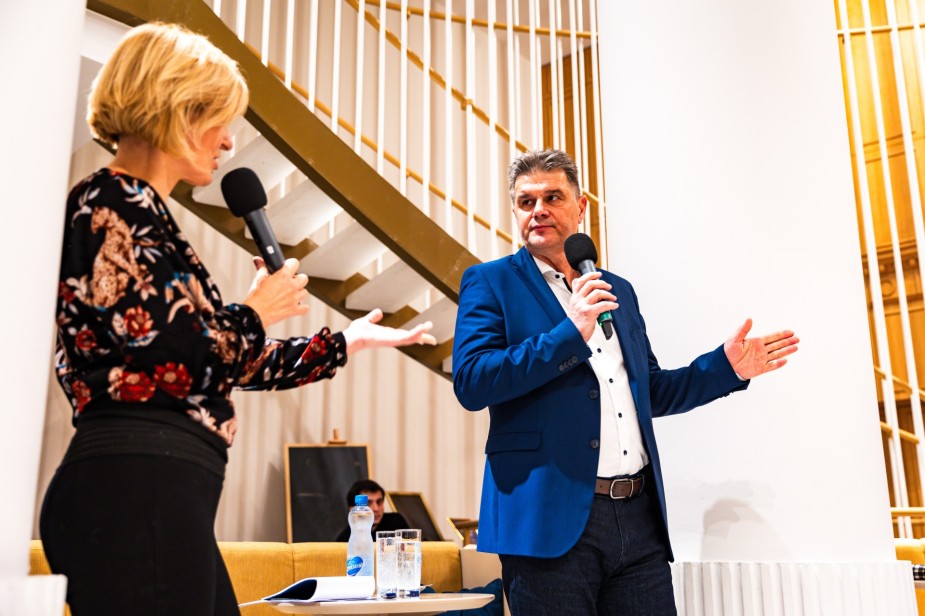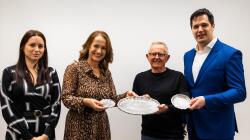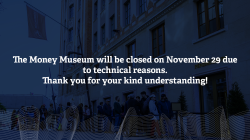
Péter Fertőszögi, Artistic Director of BÁV Auction House and Mortgage Ltd., Head of the BÁV Becsüs Academy, was the guest of the Money Museum coffee house talks series, with whom we talked about the treasure-making role of objects, the impact of the internet on the art trade, fakes, but also what is worth investing in today.
You arrived early for today’s event at the Money Museum to see the exhibition. What did you think of what you saw?
That this exhibition is what a museum in the 21st century should be like. It is modern, interactive, in tune with the changing attitudes of the world over the last 20-25 years and looks towards the future.
Were you most impressed by the showcased coins? Here you can find the second largest coin collection in the country.
I spent a lot of time looking at the coin collection but let me mention that the largest collection of mints, with 25 000 pieces, in our country is at BÁV. Metalart used to be part of our group and when the mint and the commemorative coinage were split, the coins in circulation were made at the Mint and the commemorative coins at Metalart. It might be worthwhile to organise a joint exhibition with the Money Museum...
That is something we should discuss later. In any case, if I were to visit, what would you show me at BAV?
A pawnshop, the new auction house and gallery on Szent István körút, which I think is the most modern auction house in Hungary today. What goes on there is an exciting world that changes daily. For example, someone calls me and says, "I have a piece of the Hungarian coronation cloak with 3 real pearls on it, are you interested"?
Were you interested?
I was. After that phone call, I began a year of intensive research to prove the authenticity of the cloak. Then it was auctioned off for 17 million Hungarian forints, and today it is on display in the National Museum as a national treasure.
Does your pulse rise when you get a call like this?
In the past, yes, but nowadays only on rare occasions. Today I received an offer to buy a painting by 20th century Swiss painter Paul Klee, which is original if I want it, and it is not if I do not want it. I told the owner that he should authenticate it in Switzerland first. Or here's another example, yesterday I was offered a picture by Camille Corot, one of the great artists of French realism, which was a framed poster. It doesn't make my pulse race, but when history comes knocking, it's different. Such was the case with Mihály Munkácsy's picture titled “Poros út” (Dusty Road), which is now part of the collection of the Magyar Nemzeti Bank. It was auctioned in 2003, when it sold for two hundred and twenty million HUF, plus commission, so it stood at 260 million forints in total. For a long time, it was our top auction, I personally exhibited it three or four times, and to hold that painting in my hand and see the beautiful mahogany coffered wooden panel on the back was particularly exciting.
How should a beginner start collecting art?
An art collector is usually not looking for an investment, but falls in love with the objects, educates themselves and then starts buying. To do this, you either must understand everything yourself or take advice from someone you trust implicitly and who knows what they are doing.
Is it worth starting your search in the flea markets? Can you still find treasures there today?
No, that world has been swept away by the internet and the art trade has been drastically transformed. Today, much of the trade is done on the Internet, often on portals of dubious credibility. I would venture to say that one in two or three of the images on these sites are fakes. It is worth making counterfeits, there is huge money in it, and in Hungary this field is not properly regulated, let alone properly sanctioned, so it is thriving. Therefore, if possible, only buy art at auctions where the auction house is responsible for the object sold and where there is a guarantee of return: for example, BÁV, Kieselbach, Virág Judit or Nagyházi Gallery, and there are also many galleries dealing with contemporary art.
Are you monitoring the counterfeiting industry?
Of course, because sometimes it's better than a thriller. Here, for example, is Wolfrang Beltracchi, the author of the biggest European counterfeiting scandal of the second half of the 20th century. His works have sold for tens of millions of dollars at auction houses such as Christie's and Sotheby's. He eventually hot caught, but over a period of 30 years, by his own admission, he forged around 300 paintings, mainly in the style of masters representing the isms of the first decades of the 20th century. He failed because of two things: one of his paintings was subjected to a paint test, and it turned out that the titanium white used in the painting did not exist in 1914. In two other paintings, samples were taken from the wood used in the frames, which was the same, while the paintings were supposed to have been 'painted' by two masters working in completely different areas and 1000 km apart. He served 6 years in prison, a movie was made about him, and today he sells his paintings under his own name for staggering sums. Only a tenth of his counterfeit paintings have been identified, as no one wants to examine the rest for fear that serious collectors and museums would have to admit they had been duped.
Have you ever been duped by a counterfeit before?
In my early days, when I collected for myself, yes. I also have 3 fake drawings; they are nice C. Pál Molnár forgeries by the way. It was a good lesson, but it only occurred once. One time, I recall, someone brought in seven Munkácsy sketches on French crown watermarked paper, signed by the master, each with an elaborate figure from a known painting. I asked for 24 hours to respond to the offer to buy. I took the drawings to art historian Katalin Sinkó to discuss the authenticity of the works. I'll never forget, she sat me down in her kitchen, put the seven drawings on the table and said, "Peter, think! What do we know about Munkácsy?" We know about Munkácsy that he was a brilliant painter, but he couldn't draw well. The only thing he used drawing for was to sketch the composition in broad strokes. I should have when seeing the figures, because they were too elaborate.
Then who made them?
His pupils, who visited the painter's studio and knew the finished painting, made sketches of it. Munkácsy was a star by then, and they picked up the crumbs as they fell, using the painter's tools and papers. What is the lesson? Be careful when buying Munkácsy sketches, especially well-drawn ones!
Those who offer a counterfeit for sale, do they know what they are selling?
Sometimes they do, sometimes they do not. One of my painting expert colleagues has a good catchphrase for rejection. He always says, thank you, we don't want this object because it was painted in the artist's last period right after his death.
Is what our grandparents believe to be valuable, valuable?
In the internet age, the speed of thinking has changed dramatically, and this has transformed our entire world, which is now reflected in the art trade. I'll give you examples: in the eighties and nineties, our grandmothers bought Zsolnay and Herendi tableware in the hope of their value increasing over time. Today, the grandchild brings in the tableware their grandmother bought for a million, hoping to receive five million Hungarian forints, and we give them 400,000 forints for it, because there is no demand for it, since nowadays young people eat from IKEA plates. In the same way, need bonbonnieres, nipps, and the porcelain dog from Holloház are not needed either. We don't need the display cases in which they were kept, we don't need the tabernacles, the carpets, the pianos with ivory keys. If I say that today it is difficult to sell a Bertalan Székely, a Karoly Lotz or a Munkácsy painting, people look at me in disbelief.
What sells well then?
Ilona Keserű, Imre Bak, Béla Kondor's pictures are selling well. The new art collectors want to see colour, they want to see modernity, they want to collect experiences rather than objects, and this is reflected in the art trade. Oldtimers, branded watches, retro objects, space age objects of socialism are new categories in the art trade. The plastic furniture in the shape of an hourglass or shell, which everyone wanted to get rid of, is now selling for thousands of euros. The object culture of the sixties, seventies and eighties, whether it's a vase by Livia Gorka or a designer floor lamp, is of value. Today, buying a Mednyansky, Munkácsy or Vaszary painting is merely an inflation-based investment. There is always a big profit to be made if one collects paintings of one's own era or of the period immediately before it, that is to say, those that have not yet been canonised. Selling a well-chosen picture bought in the seventies for three thousand forints can also bring in a profit. Why? Because it has become a marker of its age and has therefore become more valuable, because such a picture is a historical perspective for art collectors under 40 today, and they want to put it in its place according to their own values. Those who used to buy modern Zsolnays and eosino ceramic figures from flea markets for 3000 HUF can also be well off, because today rarer pieces can be worth 150-200 thousand HUF. If you can, collect things from your own century!
So, from an investment point of view, I shouldn't even think about buying an art deco clown?
It is interesting that there are exceptions, eras that are still enjoying their renaissance. Art Nouveau was like this 15-20 years ago, and Art Deco is like this today, because with its simple geometric forms, this style speaks to the people of today.
You are successful in this field, even starring in Treasure Hunters. What do you think is the extent of the art treasures that can be found in this country and is owned by the public?
Much less than in Western Europe. The storms of history have not allowed Hungary, which is a thousand years old, to accumulate a thousand years of material culture. Since Mohács we have been practically occupied. For me, being in the Treasure Hunters is also exciting because it makes me curious about what people bring in. At the same time, I am proud that the show has managed to put Hungarian intellectuals back in television, and that it has also drawn attention to the domestic art trade. I have experienced this first hand; the show brings people into the auction houses and more and more people ask me what they should buy as an investment. My general suggestion is to buy something that they can live with, because if they can't sell it well, at least the aesthetic experience is still there.
Listen to the full interview on Spotify, by clicking on the link below: https://open.spotify.com/episode/5d8CO3dM2AmFsTam5rI4su
Further news
All newsThank you for your kind understanding!
The success of the HUNOR Program is now on display in the exhibition space
The Tarnay family brought silver bowls
Thank you for your kind understanding!
Thank you for your kind understanding!
The success of the HUNOR Program is now on display in the exhibition space
The Tarnay family brought silver bowls
Thank you for your kind understanding!



